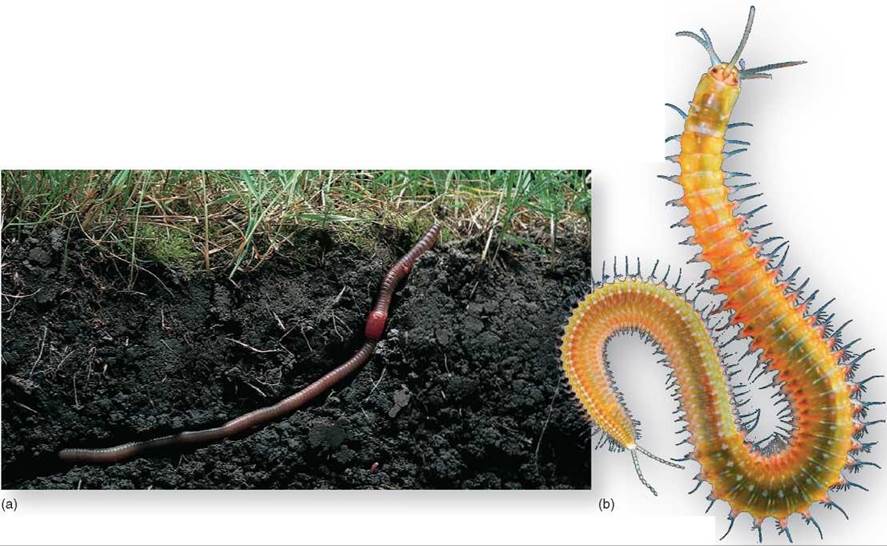THE LIVING WORLD
Unit Five. Evolution of Animal Life
19. Evolution of the Animal Phyla
19.9. Annelids: The Rise of Segmentation
One of the early key innovations in body plan to arise among the coelomates was segmentation, the building of a body from a series of similar segments. The first segmented animals to evolve were the annelid worms, phylum Annelida. These advanced coelomates are assembled as a chain of nearly identical segments, like the boxcars of a train. The great advantage of such segmentation is the evolutionary flexibility it offers—a small change in an existing segment can produce a new kind of segment with a different function. Thus, some segments are modified for reproduction, some for feeding, and others for eliminating wastes.
Two-thirds of all annelids live in the sea (about 8,000 species, including the bristle worm in figure 19.16b); most of the rest—some 3,100 species—are earthworms (shown emerging from underground in figure 19.16a). The basic body plan of an annelid is a tube within a tube: The digestive tract, the light pink tube in the Phylum Facts illustration on the facing page, is suspended within the coelom, which is itself a tube running from mouth to anus. There are three characteristics of annelid body organization:
1. Repeated segments. The body segments of an annelid are visible as a series of ringlike structures running the length of the body, looking like a stack of doughnuts.
The segments are divided internally from one another by partitions, just as walls separate the rooms of a building. In each of the cylindrical segments, the excretory and locomotor organs are repeated. The body fluid within the coelom of each segment creates a hydrostatic (liquid-supported) skeleton that gives the segment rigidity, like an inflated balloon. Muscles within each segment pull against the fluid in the coelom. Because each segment is separate, each is able to expand or contract independently. This lets the worm’s body move in ways that are quite complex. When an earthworm crawls on a flat surface, for example, it lengthens some parts of its body while shortening others (see figure 22.8).
2. Specialized segments. The anterior (front) segments of annelids contain the sensory organs of the worm. Elaborate eyes with lenses and retinas have evolved in some annelids. One anterior segment contains a well-developed cerebral ganglion, or brain (the yellow bulbed structures in the illustration).
3. Connections. Because partitions separate the segments, it is necessary to provide ways for materials and information to pass between segments. A circulatory system (the red vessels in the illustration) carries blood from one segment to another, while nerve cords (the yellow chainlike structure along the ventral wall in the figure) connect the nerve centers located in each segment with each other and the brain. The brain can then coordinate the worm’s activities.

Figure 19.16. Representative annelids.
(a) Earthworms are the terrestrial annelids. This night crawler, Lumbricus terrestris, is in its burrow. (b) This bristle worm is an aquatic annelid, a polychaete.
Segmentation underlies the body organization of all complex coelomate animals, not only annelids but also arthropods (crustaceans, spiders, and insects) and chordates (mostly vertebrates). Vertebrate segmentation is seen in the vertebral column, which is a stack of very similar vertebrae.

Key Learning Outcome 19.9. Annelids are segmented worms. Most species are marine, but some— about one-third of the species—are terrestrial.